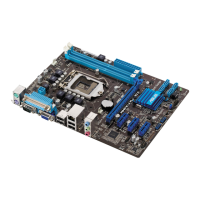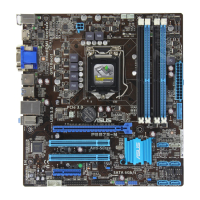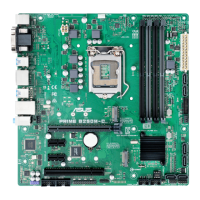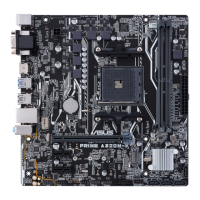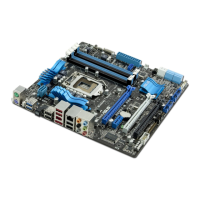
Do you have a question about the Asus P8H67-M PRO/CSM and is the answer not in the manual?
| Form Factor | Micro ATX |
|---|---|
| Chipset | Intel H67 |
| Socket | LGA 1155 |
| Memory Slots | 4 x DIMM |
| Maximum Memory | 32GB |
| Memory Type | DDR3 |
| PCI Express x16 | 1 |
| PCI Express x1 | 2 |
| PCI Slots | 1 |
| SATA 3Gb/s Ports | 4 |
| SATA 6Gb/s Ports | 2 |
| USB 2.0 Ports | 12 |
| USB 3.0 Ports | 2 |
| Audio | 8-Channel |
| Audio Codec | Realtek ALC892 |
| RAID Support | RAID 0, 1, 5, 10 |
| LAN | Gigabit Ethernet |
Guidelines for electrical and operation safety to prevent damage and injury.
Explanation of symbols, terms, and typographical conventions used in the manual.
List of items included in the motherboard package for verification.
Key features of the motherboard, including CPU socket, chipset, and memory support.
Description of exclusive ASUS technologies like EFI BIOS, MemOK!, TurboV, and AI Suite II.
Essential safety precautions to take before handling or installing components.
Diagrams and descriptions of the motherboard layout and component placement.
Step-by-step instructions for installing the CPU into the LGA1155 socket.
Guide to installing DDR3 DIMM modules into the motherboard sockets.
Information on using PCI/PCIe slots, expansion cards, and configuring jumpers.
Identification and function of all rear panel and internal motherboard connectors.
Explanation of MemOK! switch, Standby Power LED, and DRAM LED functions.
Guidance on OS installation and utilizing the motherboard support DVD.
Guides for using ASUS Update, EZ Flash 2, CrashFree BIOS 3, and BIOS Updater.
How to enter and navigate BIOS setup, including EZ and Advanced modes.
Configuration of system language, date, time, and security settings in BIOS.
Settings for CPU, memory, GPU overclocking, and voltage adjustments.
Configuration of CPU, SATA, USB, and other system devices in BIOS.
Display of system temperatures, voltages, and fan speeds.
Settings for boot device priority, NumLock state, and logo display.
Utilities like EZ Flash 2, O.C. Profile, and options to save/discard BIOS changes.



